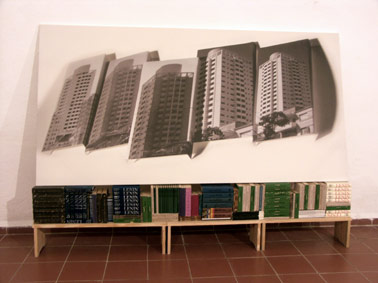After
in 1989 at the Third Havana Biennial the articulating axis of the
general discourse the event should adopt became for the first time
a matter of reflection, it has been difficult for us organizers
to escape from a thematic scheme(1). Perhaps the
eighth edition, ope-ning in November of 2003, succeeded in tightening
at least in one of its nuclei, the supposed limits of such a model,
when under the label of Art with life we tried to distinguish some
of the operations that demonstrate such conjunction rather than
precise narratives around the subject. Collective projects such
as Isaroko, Mover las cosas, 30 Días de acción (of
the Department of Public Interventions), or proposals such as those
of Daniel Lima, BIJARI, the ENEMA collective, and the Grupo Nómada,
gave an account of it. In parallel, and according to the already
traditional scheme, other works – original, as well as recurrent
in the event at the Fortress of San Carlos de la Cabaña–
dealt with very diverse subjects, from the ample and comfortable
perspective of the universe of relations established between art
and life.
Some
time later, just in the time when the dialog aiming at conceiving
and designing the Ninth Biennial started, some of the curators became
interested in the idea of continuing to develop the possibilities
of insertion of the event in the physical and social cartography
of the city, which lead them to think on the convenience of planning
workshops that would propitiate that Cuban and foreign artists and
designers worked together, in close contact with sectors of the
population of the City of Havana. The workshops would be conceived
taking in mind, on the one hand, local needs of urban nature and,
on the other hand, problems of artistic-cultural nature, whose conflictive
knots would once again be loosened or tighte-ned through the groupally-generated
discussions and actions. But except for the alternative clothes
workshop, coordinated by guest curator Pedro Contreras, no other
took place or even went past the planning stage, because of the
lack of the essential minimum budget in some cases, and in others,
because accomplishing it required, as an old colleague of the team
said some time ago, involving many and sensitizing everybody, which
is not always possible.
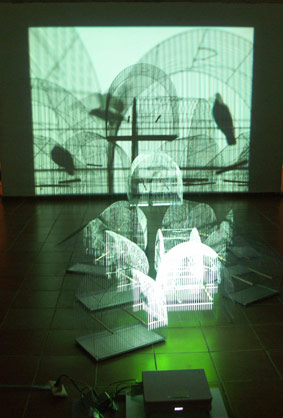 Elder
Santos (Brasil) Instalación
2006
Elder
Santos (Brasil) Instalación
2006
PHOTO:
Ximena Narea |
Thus, the workshop on urban furniture was a failure –its
purpose had been to discuss the relations between sculpture
and design of furniture as a matrix, and to invite several
artists from in the sculpture field who had explored the possibilities
of this type of objects, to produce scale models and prototypes
of viable projects for our restricted production context,
to be installed –perhaps– in public spaces of
Havana City. Another of the workshops was to be related to
the popular, abundant and varied feasts in most of the countries
participating in the Biennial. In its latest editions, some
voices had mentioned the distance of the event with respect
to the expressions of popular culture, previously exhibited
without false complexes side to side with contemporary formulations
that refer to or start from its codes and procedures(2).
It would not make sense now to go as far back as to issues
such as wire toys and Mexican rag-dolls, or to retake the
thesis of cultural appropriations and inter-crossings(3),
but it did seem attractive to explore the renewal behavior
of many of the expressions that are part of the urban culture
at the present time, some of which can find in the carnival
an agglutinin support. Thus the idea surged of linking the
workshop with the Havana carnival, preserving the best and
modifying, with constructive vocation, ideas and stereotypes
that result in the impoverishment of the visual characteristics
of such yearly celebrations. It was interesting, for example,
to retake experiences like the one undertaken by the Cubans
Omarito and Duvier in the Parrandas de Remedios, and to give
part to architects, designers and craftsmen in what would
become a laboratory sustained in the today almost abandoned
belief of the transforming capacity of art, antipodal to disillusion
and indifference.
Close
to the former, regarding to the possibility of tending bridges
towards the popular culture and of bringing artists, anthropologists
and practitioners of various disciplines together, a workshop
was conceived focusing on designing and making toys and
other objects as a form of play, with the added participation
of children and adolescents. At the same time, it was intended
to explore the behavior and the transformations of the artisan-made
toys, incorporating modern materials and urban references
for the elaboration of new prototypes, while fighting to
maintain a place within the market of practical and symbolic
goods.
The
fifth workshop was conceived with the aim of provoking a
discussion on the various modalities of projects for social
insertion through art, as well as the reciprocal acquaintance
of experiences developed by artists who live and work in
different contexts and circumstances. The challenge was
to make this workshop work, as much from the theoretical
as from the practical point of view, taking into account
that the development of an effort of articulation with communities
demands of the artist to venture into and to apprehend the
local surroundings, which requires of a period of permanence
in the field, which in turn requires of some financing (this
planted beforehand the seed of doubt with respect to its
possibilities of real concretion). Such space would facilitate,
in principle, the debate on questions of ethical, aesthetic,
educative and practical-functional character, largely decisive
for the degree of effectiveness of this type of projects
and, as well, it would invite to reflect upon the (in)convenience
of its juxtaposition to the structures of Biennials and
other curatorial initiatives, ta-king into account that
these practices generally question the limits of art as
an institutionalized exercise and that its viability, in
these cases, is proportional to budgets, authorizations
and even commitments that could favor or limit the spontaneous
unfolding of many processes. Several reasons caused this
idea to dematerialize before it got to be objectivated in
a workshop: the field investigations were this time very
limited in Africa and no curator could reach Asian regions,
where it would have been necessary to esta-blish the existence
of such practices and the ways in which they are articulated
and manifested, in order to later determine whether they
can or cannot be understood by the same keys by which they
are interpreted in the West; likewise, it was not at all
clear whether there was a budget that guaranteed the (obviously
essential) attendance of the participants, nor the communication
with a Cuban artist wishing to be appointed coordinator
of the workshop was effective.
|
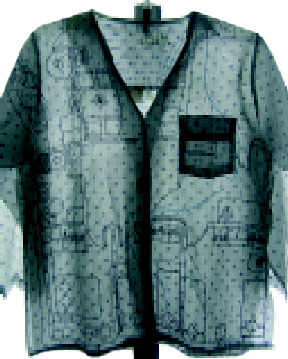 Margarita
Pineda (Colombia): Mental territories.
Margarita
Pineda (Colombia): Mental territories.
PHOTO:
CENTRO WIFREDO LAM PUBLICATIONS STAFF |
|
|
Besides
dislocating the traditional structure, these workshops could
be opened as potential nuclei to unlimited practical possibilities,
connecting to each other and establishing links with the
theoretical core of the Biennial, whose agenda did not lack
topics that would have been of common interest. By this
time, the processes of creation and exchange would have
a more relevant role, the practical aspects would displace
the expositive to a greater extent, and it would be attempted
to give continuity to a process of interaction with the
city already undertaken on previous editions(4).
Nevertheless, it would be worth asking oneself to what extent,
by this method, the Biennial would have assumed a confined
position in a dangerous –in some ways, exclusive–
localism, hardly interacting at all with the Havana context,
or if, on the contrary, whenever giving up this structure
of laboratory-workshop, it made equal sense to return to
explore urban aspects closely bound to the subject of the
city, recurrent in multiple curatorial proposals during
the last decade(5). A possible answer to
the second question could be seen between the March 27th
and April 27th of this year at the Fortress of La Cabaña
and other spaces occupied by the event... although it is
worth to notice that there were other alternatives.
After
all, the Biennial carried out only one of its workshops
and the exhibitions perpetuated its primacy, having as an
articulating nucleus the one announced as Dinámicas
de la cultura urbana [Dynamics of urban culture]. From the
beginning, some curators were shure of being able to offer
a renewed point of view about this topic –and beyond
the workshops– in relation to other international
shows such as Iconografías metropolitanas(6),
or national ones like Ciudad, metáfora para un fin
de siglo(7); others among us, however,
suscribed to the idea with a certain measure of skepticism.
The differing note allegedly consisting on that here, the
emphasis no longer would fall upon everything regarding
the urban in its dynamics, but, particularly on the culture
being born, developed and transformed within the urban territories
and their peripheral areas.
As
I see it, it would have been essential to fix beforehand
–in order to orient the search in methodological terms–
the perspective(s) from which we would approach the notion
of urban culture, considering that it has been approached
in different ways by anthropo-logy, sociology and more recently,
by cultural studies; and from that perspective, to discuss
in greater depth to what extent this complex notion, that
integrates multiple dimensions and repertoires, could act
as a thematic-conceptual axis in the work of professional
artists: “to see itself staged”; or if, on the
contrary, the Biennial had to concentrate its attention
on proposals oriented to fulfill an urban function, whose
constitution overlapped itself in the intricate weave of
relations coming to life in the city, in interaction with
the culture that developing there, exposed to constant processes
of contamination and hybridization. I talk about, for example,
proposals developed not necessarily from spatial circumstances,
but about those sites where the interests of various disciplines
converge, thus emer-ging more experimental and analytical
repertoires, or about projects with incidence on complex
urban situations, that shed light on marginalized social
groups and expressions discarded by the dominant culture,
to mention only two examples.
|
|
|
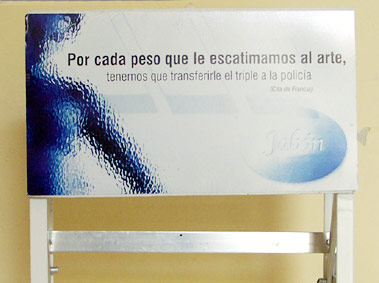 C.
Jancowski (Mexico-Germany): AGUA WASSER
C.
Jancowski (Mexico-Germany): AGUA WASSER
PHOTO:
Ximena Narea |
We also know that the selection of a subject
of reflection, able to be coherently elevated as an articulating
guideline of the discourse of an exhibition, is determined in the
first place by its endorsement by the organization. Reviewing processes
concerning passed editions, I remember how after elucidating in
a group an interesting subject –often controversial and with
sufficient potential as to support counter-discourses postulated
from the South– the way was paved for the ne-cessary exercise
showing an approximated measurement of its practical feasibility,
through the study of the archives and, even, of what had been exhibited
in previous editions of the event. In this occasion, with equal
intention and following custom, some names were thrown on the table
of discussion as previous training to the search in situ, although,
in my opinion, the exercise was not taken up to a fully enlightening
point. And in effect, shortly after, during the revision of the
material gathered after investigations conducted in a limited number
of countries, or by the means of the Internet and electronic mail,
it was noticed that it is not precisely the nexus with the Dynamics
of urban culture that best potentiates the contemporary production
of the regions involved in the Biennial or, at least, the one with
limited resources that can arrive in Havana(8).
It was thus how the span of the selection criteria had been wi-dened,
now in a definitive way, towards other parcels of the urban field.
From
the above, it could be inferred that, although during the discussions
previous to the process of selection of guests, some of the guidelines
of whatever could be placed in the area one of the “Dynamics...”,
lacked clarity on the matter. It is not less certain that during
the field research, the notion at issue tends to expand and, in
direct connection with praxis, new sources not a priori identified
by the curators can be detected; the knowledge of the context where
the artist creates allows to state how, what at a distance could
seem irrelevant, can contribute with other meanings and become data
that reveals cultural specificities. However, it becomes essential
to distinguish from the preliminary dialogs (above all, when one
attempts to focus a subject from new angles) what, because already
explored or overstated, must be immediately discarded. Let us say,
for instance, that at the Fortress of the Cabaña, considerable
segments of the exhibition showed, through photography and to a
lesser extent through video and painting, fragments of urban landscapes
focused on the architectural and physical particularities of some
cities. I am not going to stop here to analyze to what extent what
was included in them could be considered as the vanishing lines
of the ge-neral subject, which was, after all, assumed by the curators,
but the uncomfortable reiteration could not even be justified as
a conscious alert –emitted by the curators– about a
phenomenon related to fashion and to the interests of the market
–something well-known already(9)–,
nor under the argument referring to the vindication and actualization
of a traditional genre (landscape) based on the use of “new”
means –which would be another self-evident truth. An opportune
selection would have avoided unjustified re-incidences, and at the
same time granted greater visibility to the better elaborated proposals:
those that revealed, at least, more subjective relations of the
individual with his surroundings(10).
|
|
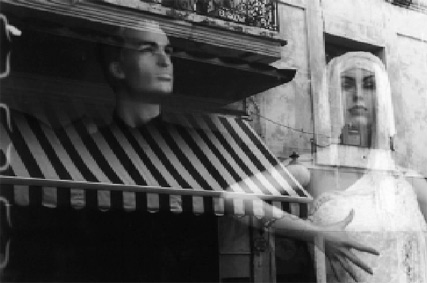 Pedro
Abascal (Cuba): Labyrinth, photographic installation
- 2006
Pedro
Abascal (Cuba): Labyrinth, photographic installation
- 2006
PHOTO:
ARCHIVO CENTRO WIFREDO LAM |
|
On
the other hand, the label “Dynamics...” had created
without doubt expectations as far as the pre-sence of a public art
developed according to the ideas of coexistence and participation,
suitable to mobilize the city around it and to again place the artistic
within a framework of wider sociocultural relations –highlighted
by Modernity as an independent entity–. Although experiences
of this character weren’t scarce, I must admit that they were
present in insufficient numbers, and not all of them did attain
the degree of ideo-aesthetic consistency that would have granted
them a considerable resonance in our metropolitan space(11).
In parallel, and agreeing with “the Third-World” vocation
of the event expressed among its founding precepts, it should no
longer contemplate actions undertaken in Havana, but in other cities
of the South, for the sake of underscoring the behaviors of these
practices when they are projected from the specificities of other
contexts. The transfer of such experiences to an exhibition of the
scope of a Biennial usually takes place through registries documenting
the processes by means of the use of photo-graphies, videos, texts,
objects, etc. Facing isolated proposals of this kind, the curators
showed a certain reluctance during the process of selection, taking
into account that not always this documentation is attractive from
the aesthetic point of view and this, sometimes together with the
scarcity of information and other times with a careless design of
the exhibition, lead to a decrease of its communicative capacity
and, consequently, to the boredom of the spectators. Thus, among
the few selected registries we could consider Oferta de empleo,
of Álvaro Ricardo Herrera (Colombia) and those corresponding
to Agua-Wasser (Mexico) and to Territorio Sao Paulo(12)
(Brazil).
|
|
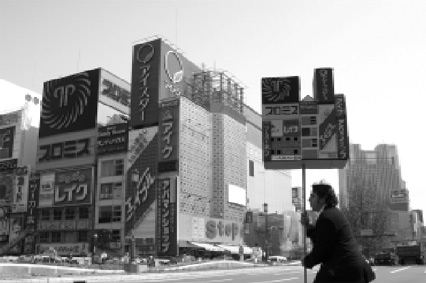 Jordi
Colomer (Spain): Anachitekton (Osaka). Photography -
2004
PHOTO:
ARCHIVO CENTRO WIFREDO LAM
Jordi
Colomer (Spain): Anachitekton (Osaka). Photography -
2004
PHOTO:
ARCHIVO CENTRO WIFREDO LAM |
|
Besides,
as it could be noticed, the balance shifted this time in favor of
photography and video, which was noticeable in the prevailing disposition
of the Fortress of San Carlos de la Cabaña. Previously, and
especially from the Third Biennial (1989), installations had been
gaining presence within the the event, strengthening their protagonism
in the fifth edition (1994). Some interested people started to wonder
at that time whether the predominance of this support obeyed to
programmatic aims of curators. In fact, the conditions of self-reflectiveness
proposed by the Biennial in each edition, used to materialize in
neoconceptual proposals based on this grammar, thereof its preeminence.
It was during the Fourth Biennial (1991) when the Fortress of the
Tres Reyes del Morro was used for the first time as an exhibition
space and soon, in the fifth, the event extended to La Cabaña.
The huge dimensions, the stony and forceful character, and the memory
load these spaces hold, usually causes a strong impression on the
foreign artists arriving to exhibit, even though they beforehand
received plans and photographies of them. Difficult to “domesticate”,
and non-susceptible to become neutral containers as a docile “white
cube”, they behave in a more benevolent –and even favorable–
way, when lodging works of installation profile involving the empty
space into the structure of the artistic object, but “swallow”
or tend to turn almost invisible bi-dimensional works of small and
medium size. Their use demand, therefore, a careful museistic design
and certain conditions of display(13).
This
time, some spaces remained half-empty, unba-lanced, and the faults
in the museography accentuated the irregular character of the selection.
Besides doing without the construction of thematic nuclei, except
with limited exceptions, neither the dialog nor the efficient counterpoint
between works functioned, as neither did opportune solutions in
order to avoid the unnecessary dispersion –all things which
would have mitigated, to a certain extent, the sensations of po-verty
and imbalance. There was in all of that a quota of responsibility
concerning the curators, in addition to the delayed arrival of works,
the material absences at the last hour, and the material limitations
above described(14); add to this the ones pertaining
to those in charge of deciding upon the emplacement and –
by the way –of the permanence time of some works in the urban
space.(15)
|
|
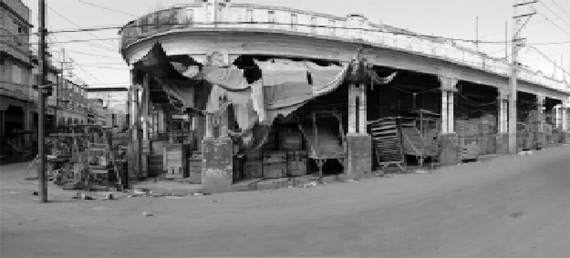 Roberto
Stephenson (Haiti): No title, digital impression. - 2004
Roberto
Stephenson (Haiti): No title, digital impression. - 2004
PHOTO: ARCHIVO
CENTRO WIFREDO LAM |
|
Going back in time, I would say that already the
sixth Biennial in 1997 sent the first intermittent signals about
the necessity to rethink the structure of the event. Incipient attempts
of transformation have taken place in the successive editions with
partial results, achievements and errors; but the ninth edition
rang the alarm like no other, emphasizing that urgent and vital
necessity of renovation. For it, it will be essential to contemplate
not only aspects concerning the structure and the regularity of
the model, but to review its intentions and projection according
with the complexity of the changes that have taken place in the
world-wide geopolitical map, the national and international artistic
scene, and the demands and operating exigencies of new means, languages
and ways of operationalization; all that, without losing sight of
the restrictions that the accomplishment of an international Biennial
implies from our own here and now: that is the challenge. Through
the years we have received very objective criticisms –which
we always receive gratefully– as well as judgments that denote
a superficial approach to the art of the regions that the Biennial
focuses on, and an ignorance or underestimation of the conditions
under which it takes place. The present circumstances are not the
same ones that caused the irruption of the event in 1984, as the
interests to conciliate are not the same either. To project utopias
never was the most difficult thing to do –the greatest challenge
lies in making it viable to attain their materialization. In this
way, any criticism or suggestion is welcome.
NOTES
1
The Third Biennial of Havana was articulated around the
coordinates Tradition and contemporaneity. It is worth to
explain that the interest was in no way focused on emphasizing
a notion of constructed cultural identity only from the
perspective offered by this polarity – a reductionistic
criterion that would have only entailed the construction
of a pseudo-identity. Rather, the event called upon the
attention of one of the multiple characteristics qualifying
a significant area of the contemporary production of the
countries of the so called Third World.
2
In the Third Biennial, whose subject was Tradition and contemporaneity,
as mentioned above, the exhibitions Juguetes de alambre
africanos, Bolívares en talla de madera and Muñecas
mexicanas, among others, caused the connivance in a “legitimizing
space”, of sophisticated works emanated of the so-called
cultured art, with living expressions of popular art (not
forgetting others that have arisen from the contamination
of both registries), thus marking its stance in this debate.
With similar intentions, the exhibition Arte del Pueblo
de Weifang, which reunited an important collection Chinese
kites, was sown at the IV Biennial.
3
Apropiaciones y entrecruzamientos were one of the five nuclei
of exhibitions that under the general subject Art, society
and reflection, were presented at the Fifth Biennial of
Habana in 1989. The show did not exalt those works that
resort to the quote, the paraphrase, the parody, and to
postmodern variations of Art History’s masterpieces,
but proposals where connections between groups of symbolic
production of diverse sign co-exist in the Asian, African
and Latin American countries. This exhibition reunited works
that reflected an interest in expanding the limits of the
potentially adaptable, establishing conscious and unbiased,
nexuses of differentiated nature between the traditional
and local popular culture, the referents of primitive and
pre-Hispanic cultures, the lexicon that emanates of the
mass media and the symbolics associated to the market.
4It
is important to point out that this would not be the first
time that the Biennial would call for the participation
in workshops, although in this opportunity they would play
a wider and more protagonic role within the general structure
of the event, no longer because of the number of workshops,
but because they would attract a very significant portion
of the list of guests. For more information on the workshops
carried out in previous editions, see the catalogs of the
Third and Fourth Biennials.
5
In fact, not only the city has confirmed its presence as
a subject in exhibitions, but also the urban itself, if
we considered that, according to the distinction established
by Henri Lefebvre ...the city [ is ] present, immediate
reality, practical-sensible, architectonic data and, on
the other hand, the ‘urban’ [ is ] social reality
composed of relations constructed or reconstructed by thought
(quoted by Celia Ma. Antonacci in Grafite, Pichação
& Cia São Paulo: ANNABLUME, 1994, p. 31).
6
Metropolitan iconographies was the subject of the XXV Biennial
of São Paulo in 2002. Its curator, Alfons Hug, said
about it that ...it hardly refers to the image of the metropolis
in contemporary art, but also to the way by which the currents
of urban energy influence the work of contemporary artists,
among other topics (Hug, Alfons. “XXV Bienal de São
Paulo”. Revista del Instituto Arte das Américas,
no. 1, July-December 2003)
7
Ciudad, metáfora para un fin de siglo, functioned
as an articulating axis of the II Salon of Contemporary
Cuban Art celebrated in 1998, under the curator Caridad
Blanco and organized by the Center of Development of the
Visual Arts of Havana.
8
More ambitious, powerful and actually more oriented along
such a path, projects like Caja lúdica (Guatemala),
Nortec (Mexico) and Territorio São Paulo (Brazil),
could not participate due to financial limitations. The
Nortec group, for example, fuses in its presentations multimedia,
typical electronic northern and band music, videoclips,
graphical and fashion design, and expressions of the visual
arts in general, to develop a production immersed in the
reality of the border between Mexico and the US, revealing
the crossings and transferences that are part of the weave
of the urban culture in that enclave. Territorio Sao Paulo,
on the other hand, was the name given to a project designed
specially for the Biennial of Havana by twelve art groups
that work in the streets of the Brazilian city: Cia. Cachorra,
C.O.B.A.I.A., Bijari, Contra Filé, TRancaRUa, etc.
In general, their actions promote the reflection upon urban
situations related to violence, exclusion, and the operations
of “social hygiene” of downtown areas, the excesses
of real estate and the processes of gentrification, among
other subjects. They use tools from other disciplines like
the anthropology, sociology and demography; resources from
music, the scenic arts, literature and the audio-visual;
and codes and strategies from social activism and the mass
spectacle, synthesized at a higher level of symbolic elaboration.
9
Artists such as the Germans Thomas Ruff and Günter
Förg, as well as the French Jean-Marc Bustamante, are
between the initiators of this fashion in the 90s, which
has circulated and gained adepts in different latitudes.
10
Beyond the tautological character of the collection exhibited
at La Cabaña, certain successes could be perceived,
however, through precise proposals, such as Arquitectura
del vacío by Javier Camarasa (Canary Islands), who
through an intelligent plastic solution (a fine neon light
fragmented in two the projection screen as a line dividing
and ordering time) juxtaposed two video recordings of the
same territory, taken in different stages, to signify the
devastating avalanche of real estate tourism-related enterprises
on a virgin nature, now turned into the background of motley
architectonic complexes. Anarchitekton (four simultaneous
projections) by Jordi Colomer (Spain), showed the form in
which the culture of marketing puts its mark on the architecture
in Osaka up to the point of annulling it, or how the inhabitants
of Brasilia draw up, with their everyday transit, the functional
caminhos do desejo not projected by Lucio Costa in the Pilot
Plan of that city (among other commentaries). In addition,
it is worth to mention the work of Michel Najjar, which
glimpses the effect of Telematics in the iconic representation
of the landscape of the future. Less attached to architectonic
references, other photographic proposals were dedicated
to emphasize new elements integrated into the physical and
social landscape of large cities, but in many cases by paths
already worn out by photography, or without excellent aesthetic
results. In an opposed sense to this evaluation, the collection
of digital photos by Stephenson Robert (Haiti) would stand
out, which depicts, together with the deteriorated architecture
of some areas of Port au Prince, the ethnic and psychological
profile of some of its inhabitants, in close relation with
an everyday life of precarious and multitemporary character;
or Laberinto, by Pedro Abascal, that associates to Walter
Benjamins idea of the city as an ...accomplishment of the
old human dream of the labyrinth, treated here from the
non-distinction between image and reality, in the fragmented
visual landscape of the contemporary large city.
11
Beyond the tautological character of the collection exhibited
at La Cabaña, certain successes could be perceived,
however, through precise proposals, such as Arquitectura
del vacío by Javier Camarasa (Canary Islands), who
through an intelligent plastic solution (a fine neon light
fragmented in two the projection screen as a line dividing
and ordering time) juxtaposed two video recordings of the
same territory, taken in different stages, to signify the
devastating avalanche of real estate tourism-related enterprises
on a virgin nature, now turned into the background of motley
architectonic complexes. Anarchitekton (four simultaneous
projections) by Jordi Colomer (Spain), showed the form in
which the culture of marketing puts its mark on the architecture
in Osaka up to the point of annulling it, or how the inhabitants
of Brasilia draw up, with their everyday transit, the functional
caminhos do desejo not projected by Lucio Costa in the Pilot
Plan of that city (among other commentaries). In addition,
it is worth to mention the work of Michel Najjar, which
glimpses the effect of Telematics in the iconic representation
of the landscape of the future. Less attached to architectonic
references, other photographic proposals were dedicated
to emphasize new elements integrated into the physical and
social landscape of large cities, but in many cases by paths
already worn out by photography, or without excellent aesthetic
results. In an opposed sense to this evaluation, the collection
of digital photos by Stephenson Robert (Haiti) would stand
out, which depicts, together with the deteriorated architecture
of some areas of Port au Prince, the ethnic and psychological
profile of some of its inhabitants, in close relation with
an everyday life of precarious and multitemporary character;
or Laberinto, by Pedro Abascal, that associates to Walter
Benjamins idea of the city as an ...accomplishment of the
old human dream of the labyrinth, treated here from the
non-distinction between image and reality, in the fragmented
visual landscape of the contemporary large city the Portal
del Cine Yará, in Havana. Located just in between
art and anthropology, its collection consists of voluntary
donations of people that live or temporarily visit the sites
where it is located, and translates, in the words of “its
guardians”, the spirit of the barrio that welcomes
it. Margarita Pineda (Colombia) on the other hand, walked
through markets, squares and other anodyne sites of the
city, attempting in her exchanges with the the passer-byes,
the emergency of new maps based on practices and daily rituals
enrolled in the urban experience, outlining rather subjective
territories, not determined by geography or politics.
12
Oferta de empleo was a project developed in the Mexico City
during a two-year stay of the artist. Its presentation in
Havana landed halfway between a work of author and a record,
without managing to transmit with clarity all the stages
and actions of the process. Agua - Wasser, however, conveyed
the real dimension of a collective project made in the same
City, through a moderate and properly designed version by
the curators Edgardo Ganado and Daniela Wof, which included
photographies, vi-deos, texts, scale models and other registries
on facilities and interventions made in public whose past
and/or present have a relation with water, an element that
marks the cultural history of a lake city today turned one
into a dried metropolis.
13
In the V Biennial, for example, even though most of the
exhibited works at the Fortresses of the Morro and the Cabaña
had not been conceived as interventions on the architectonic
space, the facilities showed effectiveness as far as the
handling of the space and to the advantageous use of their
intrinsic qualities in the search of certain effects. It
even happened that the dramatic aura and the communicative
force of some of those works, notably decreased when they
were exhibited later at the Ludwig Museum in Aachen, as
it was perceived by colleagues who were involved in the
assembly work.
14 As
I explained before, financial difficulties caused critical
absences in this Biennial, such as the those related to
the above mentioned projects Caja Lúdica, Territorio
Sao Paulo, etcetera, and to the participation of Brazilian,
African and Asian artists. Likewise, such difficulties prevented
the production and/or transportation of some works, which
ended up being replaced by others, or being exhibited in
poorer and inconsistent versions, thus causing the above
mentioned disadjustments.
15
The disagreements around the temporary permanence of Havana
Gold of the FA+ duo, and the location of the sculpture of
Reynerio Tamayo demonstrate a lack of understanding on the
form in which some contemporary practices operate. The golden
patina imposed by FA + to preterit elements of the urban
surroundings, with the purpose of giving them class in the
distracted or hurried eyes of the city dweller, was covered
with black painting just a short time after it had been
applied, and the sculpture of Tamayo, conceived for the
confrontation with its referent on the road where vehicles
circulate, was confined to one of the gardens of the Cabaña
and exhibited as a conventional sculpture.
|
|


